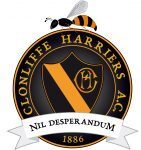Memoir of the early days of the Ladies Section Clonliffe Harriers. “Call them Morton’s Marvels. They are mustard keen lasses training with Harry Cooney who won’t stay at home knitting these shivery nights, but who, three evenings a week and Sunday mornings bus it or pedal it to Santry Stadium for high jump, shot put and track training.”
So wrote a journalist in the Evening Press on 15th December 1963, the day before the inaugural 600 yards race which took place along Santry Avenue. No cash prizes then. The winner Claire Dowling got a pair of silver candlesticks, while second place Ann Killeen got an electric table lamp. Ann’s sister Deidre was one of the first policewomen in Ireland.
The possibility of opening the doors of Clonliffe Harriers to women was first thought of, coming up to the celebration of the 75th Anniversary of the club in 1961. It was proposed by Billy Morton and seconded by Lar O Byrne. It took another 2 years for this to happen, when a meeting was held in Morans Hotel, on 5th November 1963. Enrolling took place then and the following week we all turned up for training under the guidance of Harry Cooney, with the help of Noel O Rourke and began training in the Nissan hut.
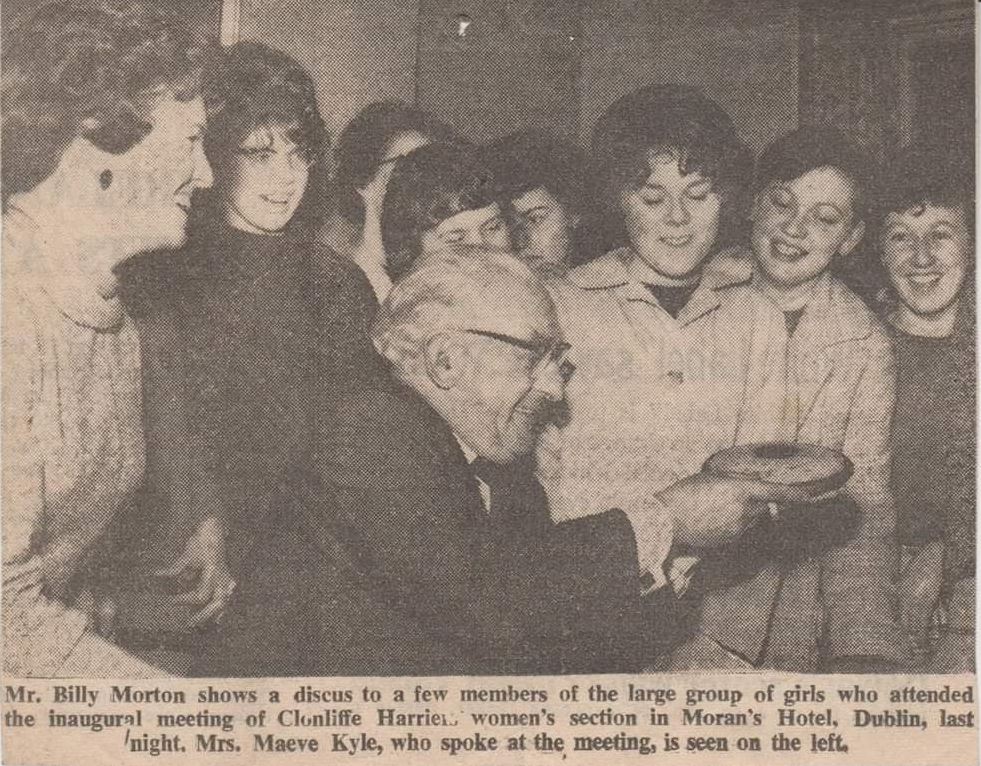
The coaching of women athletes was unknown territory for them. Harry was a marathon runner and Noel an 800m runner. They were not aware of what women were capable of, so the longest we ran in training was one mile. Gradually the distance was increased. The longest track event for women at international track events was 800 yards. Even though there was no long races we could eventually run for longer. As there was no long races we did a few time trials. This was to help Ann O Brien who wanted to run a long distance. In 1965 during a one hour time trial Ann set a world record when she ran 14,428 meters (9 miles 1133 yards). In 1966 Ann was also the first Irish woman to break 5 minutes for the mile when she clocks 4 minutes 59 seconds. In that race she lapped me. The first international cross country race for women was held in Barry in Wales in 1967.
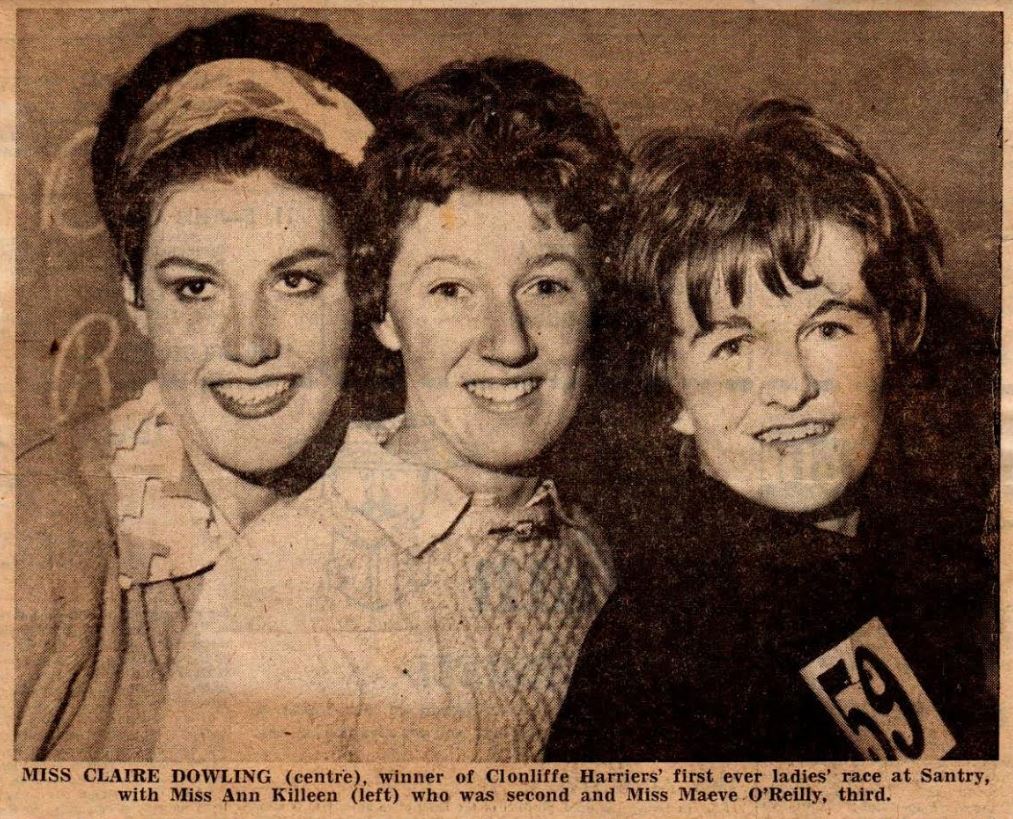
When the summer came Jack Deegan showed us how to throw shot discus and javelin which was wooden and Brendan O Reilly introduced us to the high jump which was into sand, no mat. Everyone did the same training long runs, sprints and circuit training in the Nissan but. The stabilizers for the hurdles were used for weights. Before training we would have a game of rugby with some of the men in the Nissan as a warm up. In the winter of 1964 we had an introduction to cross country by having a game of hares and hounds. It was a culture shock as we got all muck on our legs and we had to wash it off in the stream.
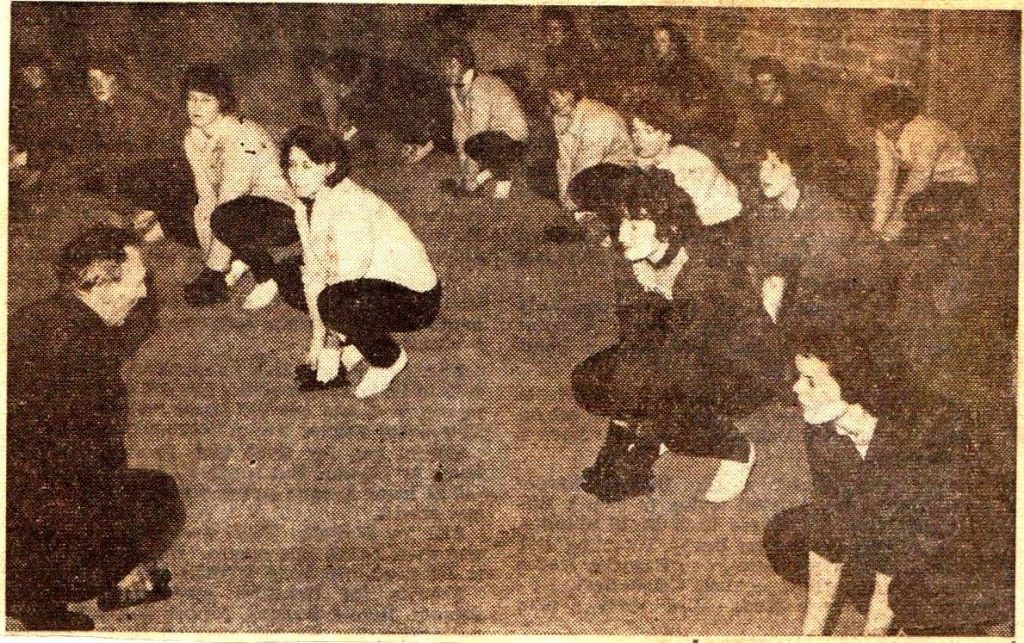
The following year 1965 we got an invitation from Bury and Rathcliff for a friendly match. The cross country was on the Saturday afternoon and there was a limited track meeting on Sunday. It was the first time I had tasted Cornish Pasties. We got the Mail boat from Dunlaoghaire. Then you could get a bed on the boat for the night and we slept in a dormitory until 6.30. We then got the train to Bury for the meeting. We were the first women’s club team from the South of Ireland to go abroad for a race. We also travelled to Ballyclare for a cross country race every second year and they came down to us. We also had cross country races against other clubs, Glaslough and St Andrews. That was the only way we could get competition. They would come to us the following year. There was not much competition for women and if the club heard of a festival anywhere in Ireland that also included running races, a bus would be hired and we would make our way to the event. There would be sprints and a distance event and maybe a relay. Afterwards there was music and a dance in the marquee and a sing song. On the way home we would drop into a pub and have another sing song on the way back in the bus.
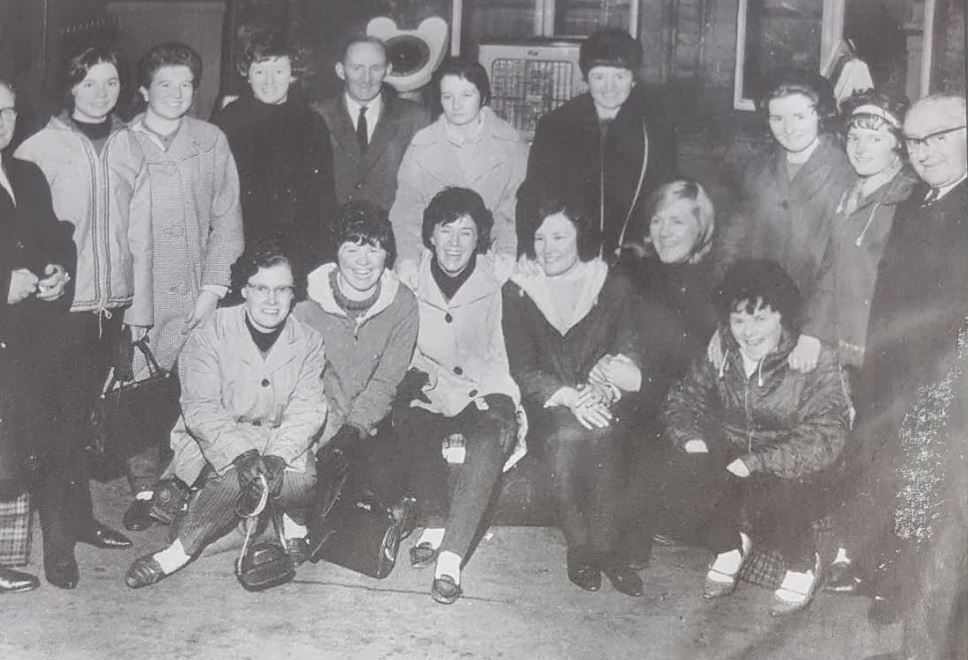
We weren’t full members of Clonliffe Harriers as two thirds of the senior male members had to agree to it at an AGM. We were associate members and because of this we had no rights. We could attend meetings but couldn’t vote. We did pay a membership but it was only10, shilling, but it couldn’t be taken by the treasurer as we were only associate members. We administered it ourselves. There was a large group of young male runners in the club training and they couldn’t believe that we weren’t full members and were insensed about it. It wasn’t until they had reached senior status and paid the full membership fee that we got a two third majority 10 years later. There was by now a new generation of forward thinking male members. We had formed our own committee and elected a captain, secretary and a treasurer. When we had enough money from the 10 shillings a year we paid to have showers installed.
On the first night after the meeting in Morans Hotel, when we arrived up to the club we were shown a shed under the stand, which had been used by Blanchardstown football club. We were told this was our changing room. There was a small room cordoned off that held an Elsan toilet. There were no toilets for women in the Nissan where the men had their changing rooms, and toilets but we couldn’t use them as they were men only. Heat in the shed was by a Superser or a one bar electric fire. Eventually toilets were built for us in the Nissen hut. When we arrived up for training one of us would fill a kettle and would put it on the pot belly stove to heat. Then when we finished training we would wash the sweat off with a damp cloth and change into dry clothes.
There was no athletic gear for women so we had to buy men’s shorts. Olive lived beside Harry Cooney and he gave her his shorts. One of the girls got their hands on a pattern and we made our own shorts. This was nearly our downfall. At that time Archbishop McQuaid was opposed to girls running around in shorts and taking part in sport wearing the shorts with men around. Regularly Billy would get a call from Archbishop’s palace telling him to stop the women running around in shorts, that is was immodest, uncatholic, unirish, and unladylike. Billy would say I hear you and put the phone down. Then one of the girls saw an ad in Athletics Weekly for stretchy knicker shorts and we ordered them. We turned up one Sunday morning in them and Billy nearly had a heart attack “be japers girls if the archbishop could see you now you would be excommunicated from the church!” I still have mine. A picture of some of the women appeared in the paper and one of the members was told to leave The Children of Mary, by the nun in charge.
One night just after joining the club Billy came up and told us about the assassination of President Kennedy and as a mark of respect he sent us home. The only events for women then was 100 yards, 200yards 800yards 80yard hurdles H.J.L.J. Shot, Discus, Javelin. During the summer months we got an invitation to the trinity sports during college week. The President of Ireland would attend and there was strawberries and cream after the event. We also took part in the Louis Vandendries trophy run by Crusaders.
After a few years the younger sisters of three of the senior members wanted to join the club. They were only very young and it wasn’t fair for them to be running against senior ladies. At this stage AAU and NACA had amalgamated to form BLE. Prior to the formation there was a NACA youth committee who organised events for juniors. After the foundation of BLE, Clonliffe ladies, Crusader Ladies and Raheney ladies got a committee together. We set it up to try to see if we could run our own events like the WAAA in England but there wasn’t enough of us as many still wanted to compete. We then approached the youth board to see if they would put on events for young girls. They agreed on condition that they had a female on the committee to help and advise as they knew nothing about girls and athletics. They put on a Sprint and a long jump. As I was on the youth committee I took the Clonliffe juveniles under my wing. During the summer we had a handicap league in the club, on a Tuesday and Thursday evening. We competed in a track and a field event each evening. It was great fun as we were still trying to find our feet. Then Maeve Kyle gave us a trophy for a pentathlon. Harry and Noel were still looking after us but nobody was coaching field events. Some of us bought books on field events and taught ourselves. Clonliffe were still a Harriers.
It wasn’t only athletics that we were involved in. The stadium was always in debt and we had to do a lot of fundraising. Billy thought that we would be good at this and we were roped into collecting money. We did door to door collections, flag days, pub crawls and even collected jumble for a jumble sale. One day we did a relay and a pub crawl from the GPO to Lanesboro. Noel Henry ran the full distance and we took turns to run with him. If there was an event such as a circus or stock car racing that Billy organised to raise money, in the stadium, Noel O Rourke would have a shop or two in the stadium. We would be helping to run the shop to get extra funds.
The first National Championships after the formation of BLE was held in 1967. The women were sent to a Farmers Field in Tipperary. The reason was that there were still some members of the opposite sex objecting to competing in the same event and arena as women. We had no transport so a kind male athlete offered to drive us there. He only had room for 4 people in his car. It was a disaster. The field was a 300 yard hilly track. The hurdles were two uprights with a bamboo stick across. Circles were grass. During the relay it rained and the white lines for the relay were washed away. We had to fight for the National Championships to be held in Santry the following year.
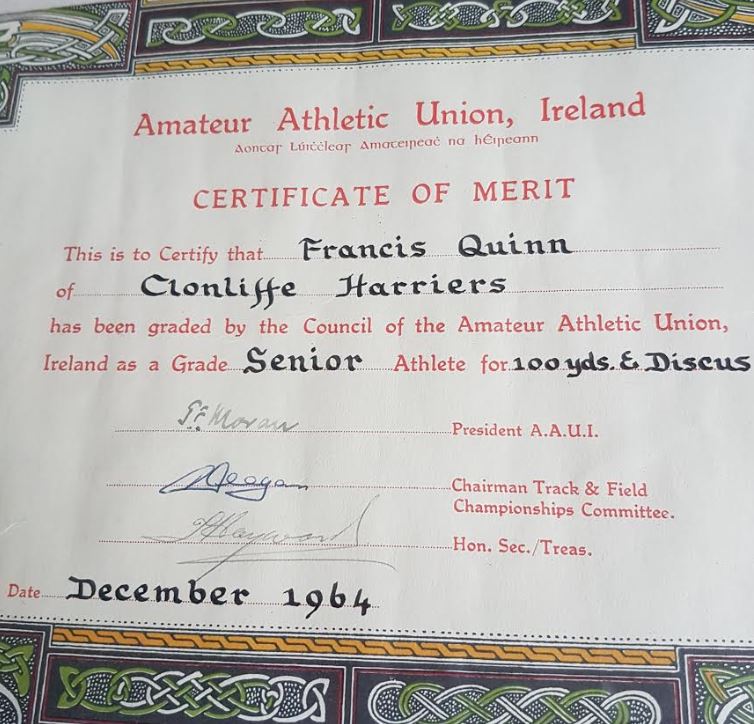
This November the Clonliffe Harriers ladies will be 57 years in existance. A lot of water has gone under the bridge during those years. We went through a bad patch in the early 1980 as many girls didn’t seem to want to run. The mini marathon and the setting up of meet and train groups revived the sport for women. Many of our ladies have represented Ireland at international events, including the Olympics and Paralympics. Thanks to the vision of those male members, who voted to open the track to women in 1963, that we got to enjoy the sport of athletics. When BLE and BLOE was established some of the Clonliffe Women took up a position on the committees. They also serve and have served on the committee of the club. It was a great day for women’s athletics and for athletics in general when Clonliffe Harriers opened the door for . The ladies section has gone from strength to strength and I hope the girls continue to enjoy the sport and get as much out of it as we did.
